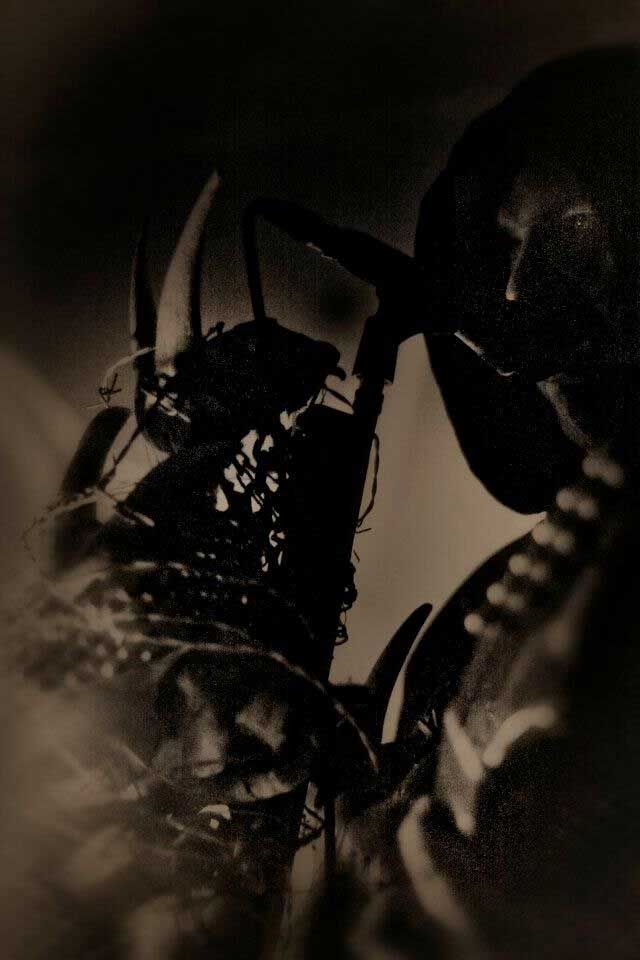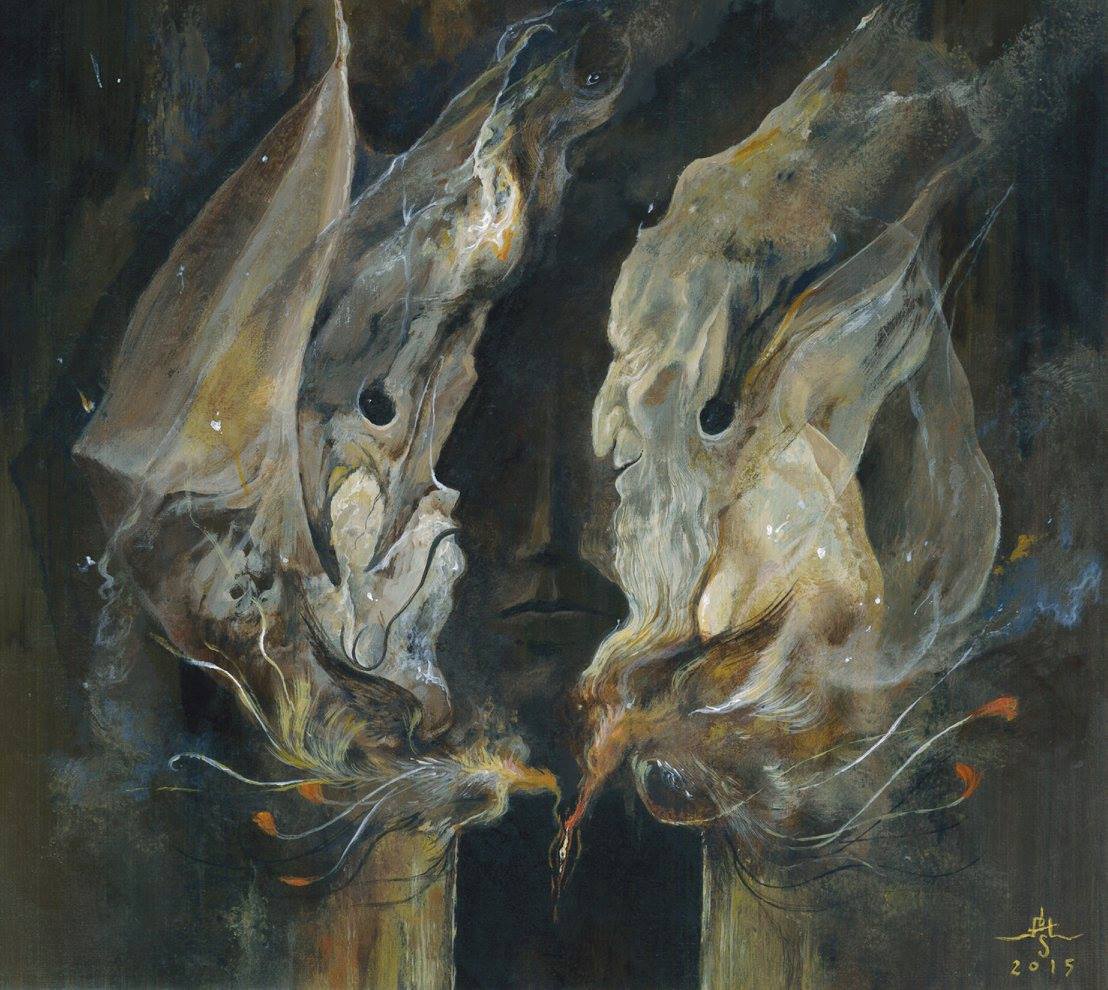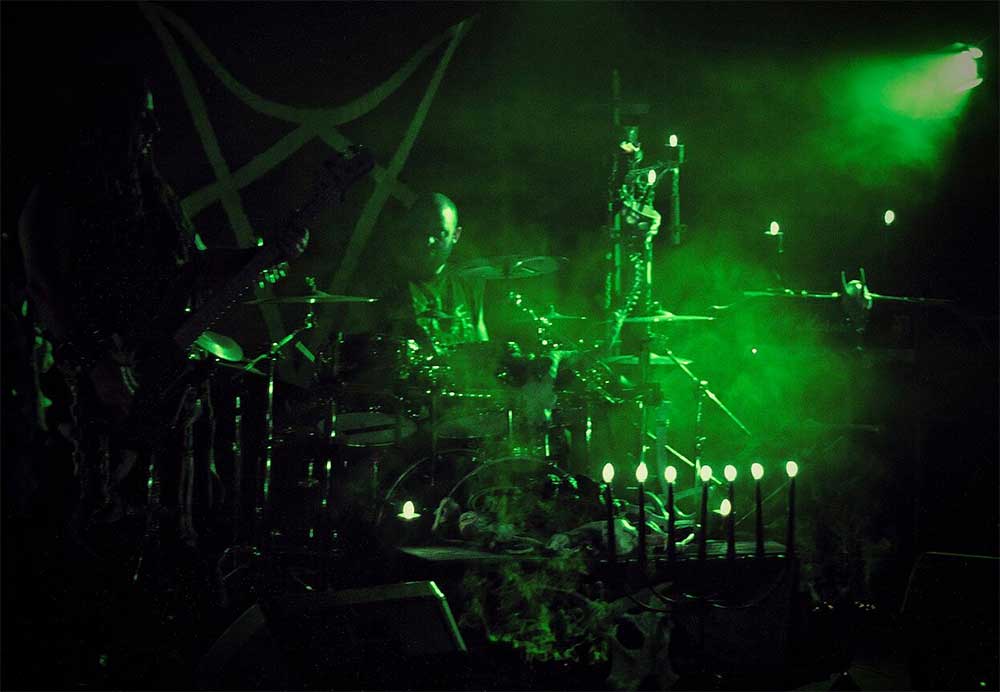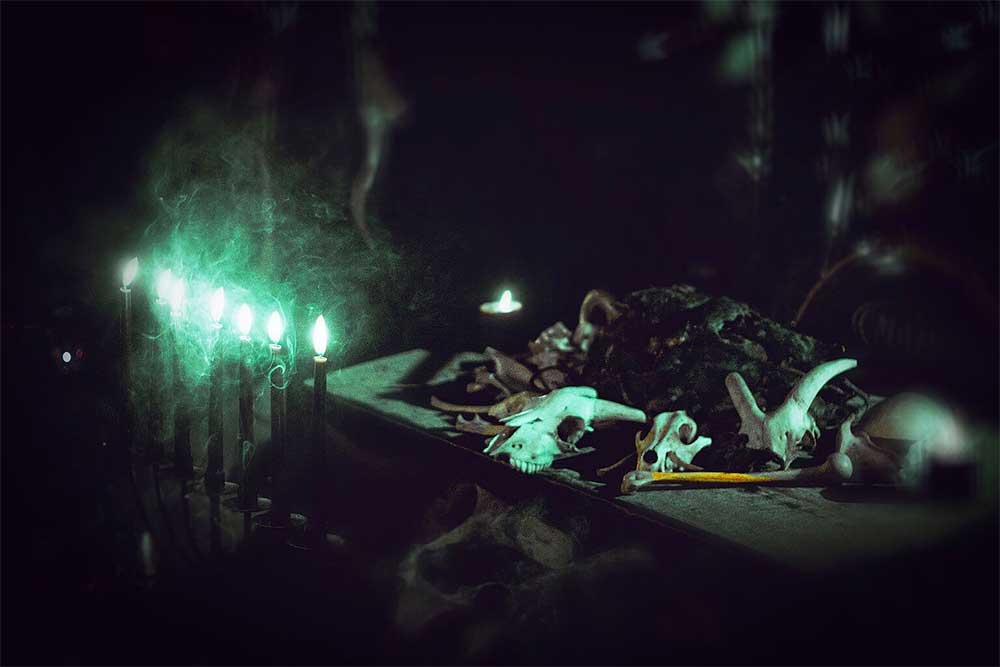Vassafor
2017-09-14
by Niklas Göransson
New Zealand black metal duo Vassafor have finalised their “Malediction”. Frontman Phil Kusabs ponders atom-splitting riddles of the quantum field, sleep paralysis, and how a cross-continental pilgrimage cemented the foundation for his vocation.
– The new album, “Malediction”, is now finished. The last stages of mixing and mastering are absolutely gruelling so it’s driven me half-insane by now – I think that’s a good thing though? I really can’t tell anymore.
The album’s production is one of its most noticeable initial impressions. It’s rather difficult to describe and unlike anything I can immediately refer to.
– I had a sound in my head, far from standard studio productions and I’m not quite sure I’ve heard it before either. My goal was for all instruments to be virtually inseparable from each other – I suppose I wanted the sum to be greater than the parts.
Phil adds that the glue which binds it all together is the devotional aspect to Vassafor, the spiritual patron of both his person and music.
– Every scrap of every element was conceived, written, performed, tracked and even mixed with that feeling. I don’t give a fuck if it’s not particularly clear or falls outside a standard paradigm of what is or isn’t a good production in this day and age – Vassafor exists outside of time. Ben and I are merely his conduits and this is the result.
In our previous conversation, published exactly one year ago, we learned how Phil’s celestial benefactor was revealed to him through a series of intense ’lucid dreams’, as he called them at the time. When I published the QRIXKUOR article a few weeks later, Phil told me that S’s description of sleep paralysis sounded in parts precisely like what he experienced in his youth. By now, I believe I’ve interviewed eight or nine artists who’ve mentioned being subjected to various symptoms of the condition during childhood – all of them claiming it to have had a profound impact on their lives and to some extent sparked their curiosity for the ‘other side’.
– I definitely found significant parallels in some of the sleep paralysis descriptions. The fundamental difference which made me not relate to some of it, however, is that I didn’t find it terrifying. At all. Quite the opposite in fact, I suppose wondrous is a better word. I always liked the freedom of being defleshed and truly dwelling outside what I would now consider space-time. I’ve always thought of this as the apprenticeship to my patron, I am him.
Online research reveals that there are people who find sleep paralysis beneficial, or even enjoyable, though they appear to constitute a mere fraction of those afflicted. Having never endured the ordeal myself, I can at least understand why most would find it somewhat unsettling. In last week’s MALOKARPATAN feature, for instance, Adam mentioned suffering commonly reported phenomena such as feelings of being physically pinned down by a malevolent presence, or waking up from sounds of growling beasts next to his head. Bugger that.
– I used to say hello to the glittering eyes under my bed when turning off the light. They were my friends, I thought. Darkness was preferable, since the dreams were always stronger in utter black. I suppose I was a strange, loner kid. It always felt as if I was being invited through the gate as a welcomed guest, or as an apprentice.

Besides his ethereal patronage, Phil says the lyrical content can be traced to both books and real-life events.
– Filtered through the Vassaforian paradigm and then vomited out in as close to an automatic writing process as possible. The music was then built from there. The reason we called the album “Malediction” is because each song came words first – even older ones such as “Black Winds Victoryant”.
The song in question features a sample of American theoretical physicist J. Robert Oppenheimer, known as ’father of the atomic bomb’. In a television interview from 1965, Oppenheimer recalls his initial reaction to watching the first successful test detonation of his atom-splitting progeny, shortly before the bombing of Hiroshima and Nagasaki in August, 1945. The full quote goes as follows:
We knew the world would not be the same. A few people laughed, a few people cried, most people were silent. I remembered the line from the Hindu scripture, the Bhagavad-Gita; Vishnu is trying to persuade the Prince that he should do his duty and, to impress him, takes on his multi-armed form and says, ‘Now I am become Death, the destroyer of worlds.’ I suppose we all thought that, one way or another.
– It’s appropriate on several levels for the record’s over-arching themes. Apart from the most obvious connotations, it also has to do with man’s pursuit of mastering ourselves within. Does our understanding of the quantum nature of this reality hold true throughout all of the multiverse? Does the ability of particles to be in multiple sets and places simultaneously explain certain workings?
In July 2017, Chinese scientists reported having successfully teleported properties of photons 1 400 kilometres (870 miles) using a physics theory called quantum mechanics. Besides appeasing Star Trek fans, it also represents a huge leap forward for an emerging technology with the power of rendering the World Wide Web entirely obsolete. The quantum internet is coming; an infinitely more powerful online platform, both in terms of sheer speed but also in enabling fully secure communication. Theoretically, since quantum objects such as photons react to being observed – a conundrum I’m not even going to try to explain since I don’t quite get it myself – any snooping attempts would be immediately detected. Phil continues his hypothesis onslaught.
– The way particles are able to interact with others at seemingly impossible distances? What about their influence through other gates into alternate spheres of the multiverse? What is Śūnyatā truly in that context? What’s its relationship to dark matter, if any? And how does it relate to man and consciousness? When we unlocked the atom, it seems to me that Pandora’s box wasn’t just sprung open in this dimension but those ripples correspond on all intersecting planes and dimensions. So, what are the nexus points that intersect…?

It was interesting revisiting our previous conversation while listening to the new record. This, for instance:
Not binaural beats or whatever, but we like to have a lot of things going on in the background, just beneath the surface; samples, sound elements and tones among other things. Anything that helps in reaching out and tugging on the listener’s subconscious.
Having now heard “Malediction”, it’s easy to see what he means. I predict it’s going to take quite a few listens to figure out half of what’s going on here.
– Now, as for why it’s all in there…. well, best put on headphones or crank up that stereo in utter blackness, let it seep into the unconscious mind and observe which sensations get triggered. Some songs have quite a lot in there, whereas others are more straightforward rippers.
Phil mentions how he’s highly fortunate to have such a perfect partner in crime as drummer Ben Parker who, besides percussion and rodent extermination, is also skilled in Foley work. This is the art form of capturing sound effects for use in films and television programs – it could be anything from footsteps and doors opening to fight noises or breaking glass.
– His side-work as a Foley artist has helped expand our sonic horizons considerably, Ben is a virtuoso for recording non-standard instrumentation and sound. We have many layers in some of these songs and while a couple of them are samples, the vast majority are recorded by ourselves in various locations.
Care to give an example?
– Ben found an old iron bumper at a job he was on and brought it home, added springs stretched taut and mic’d them up with contact microphones and then played it with mallets, hammers and a bow. We used it for the first song, which features lyrics concerning the manufacturing of a destructive force in an apocalyptic setting. Much better than just sampling some factory noise or whatever lazy shit most people might do. We did the same thing for our MZ.412 cover on the Cold Meat Industries tribute compilation. Well, I say we but in fact it’s almost all Ben’s doing – he’s a genius at it!
MZ.412 are the originators of the black industrial genre, masterminded by entrepreneurial Swedish audio terrorist Nordvargr.
– When our copies of the compilation arrived, we thought it would be appropriate to send one to the mountain behind MZ.412. Ben especially has been actively following Nordvargr’s prodigious output, which is at a ridiculously high standard. Especially when considering how much he’s creating, it’s extremely impressive.
Besides the CMI tribute, Phil and Ben also included their three-CD compilation album. They heard back from Nordvargr himself a while later, he had enjoyed the cover version and resonated with VASSAFOR.
– Ben has maintained contact and so hopefully we’ll do a split release with one of his projects in the future, we’re certainly very keen to make that happen. Anyone who might have been a fan of MZ.412 but not kept up with Nordvargr’s current material should check out his varied output, it’s a deep current of pure fucking darkness radiating stronger than ever.
2017 marks a decade since the release of VASSAFOR’s self-titled mLP.
– In the years since this release, I’ve had my hand behind many records that seem to have resonated strongly within my sphere of music. From VASSAFOR to eras of DIOCLETIAN and IRKALLIAN ORACLE, to my ongoing involvement with TEMPLE NIGHTSIDE as well as future pieces yet to strike. It’s getting easier to discharge my lightning into each project as I become more assured and strip away all hurdles in channelling it – a sinister illumination through the lamp of invisible light.
Speaking of which, Phil has previously mentioned his long-standing relationship with the Order of Nine Angles system, which was discussed a fair bit in my conversation with Northwind of The Sinister Flame. I’m quite intrigued by the ONA concept of Insight Roles, and am curious to what extent people actually engage in this. This is an escapade which requires the practitioner to undergo temporary but drastic and turbulent changes in his or her lifestyle, often entailing leaving the comfort zone of one’s home for extended periods of time.
– While I have no problem talking about almost anything, this in particular is something I prefer to cultivate privately. It seems extremely counterproductive to build something in private over an extended period only to then blurt it out for all and sundry. Not entirely unrelated, however, is that 2009 was the year I essentially became a nomad and left New Zealand for an extended period of time.
With extremely modest means of income in the various time-zones he found himself – at journey’s end in 2015, Phil had resided for various lengths of time in Canada, the United States and Sweden, and journeyed through as wide-ranging places as Italy, Finland, and the Philippines.
– While it was for a much longer period than the eighteen months an Insight Role is recommended to take, there was a lot to learn in the journey and certainly many heights and depths were traversed. I know several individuals who have undertaken more traditionally strict Insight Roles, but no need to speak of others’ experiences. As per usual, I followed my own paradigm – I’m far from a traditionalist even within this framework.

One tangible reward from Phil’s intercontinental travels is how it cemented the foundation for his current profession as a sound engineer – both from experience of working in other studios but above all making contacts and establishing personal relationships which would’ve been inaccessible to him back home in the South Pacific. I’m curious if this was part of the plan.
– Hah, calling it a plan is probably giving me too much credit, but it’s certainly always been an end goal. I came from a very far location and willed myself to be in the middle of this, I had no money or help from anyone at first but now I’m here doing all this. I’ve never seen the point of dreaming small, I worship this music and have always been single-mindedly dedicated to my art and the underground. It made sense, wanting to be in the thick of things.
Phil states that where many don’t seize the moment of opportunity, he jumps head-first and with full force into anything he can see benefit in.
– There’s a passage in the Hagakure which says that every important decision should be made within seven breaths, and that’s always made sense to me. Nothing worse than having to deal with people who second-guess every decision they make. Of course, some of my choices have been less than stellar but I try to learn from everything I do and not make the same mistake twice.
Phil says the moral of this story is that experience yields wisdom, which is worth more than any knowledge gained solely from scholarly sources.
– My situation is greatly improved because I managed to get out there and do a few productions, and now I’m back with my own setup. I have no doubt that the path I’ve led to be at this stage has given me a rather different perspective from many engineers. This is what I’ve always wanted to do for a living. Even being able to do a few good ones is great, since I generally turn away bands I don’t listen to.
Though an admirable set of principles, it doesn’t sound like an especially lucrative strategy.
– Look, I’d love to have more money and be able to improve my setup and do better work, maybe even upscale with certain training as I’m completely self-taught. But I don’t want my name, which I try to associate with quality, attached to sub-par, spiritless garbage – regardless if it means a good payday. Such things mean nothing to me; the biggest reward is having a record I can pull out of the shelves, listen to, and know that Satan smiles.
Phil says that if he can help them further their vision and ‘spread the plague’ more efficiently, then he’s infinitely pleased to do so.
– I’m proud to work with the likes of Iron Bonehead and Invictus Productions on some of their great records – two labels I have genuine respect and admiration for, I support their ideology and methodology completely. I’m always going to want to work alongside bands such as QRIXKUOR or BESTIAL RAIDS, as opposed to these flavour-of-the-month acts with no roots, heart or iron.

In the REBIRTH OF NEFAST feature published a few weeks ago, Stephen Lockhart – who also operates Studio Emissary – argued how production should be used to bring a project to its full potential as opposed to being a crutch that allows poor composition and technique to masquerade as products of purpose. He went on to say that when music is unable to retain its essence whilst subject to a high-fidelity production, perhaps the material itself is the problem. Music should be performed in a manner that fully expresses the artist’s initial intent, and its end result should be an appropriate manifestation thereof. I thought it would be interesting to hear Phil’s take on it.
– I agree to a certain extent. Absolutely right that composition is most important – that’s what the music in essence is. A good song with feeling embedded in the delivery is what moves me – I don’t particularly care if its crystal clear or recorded on a rehearsal room tape deck. The latest ACRIMONIOUS album is a perfect example.
– Utterly brilliant record, clear and transparent sound and mix but not so clean as to homogenise the music at all. You can still feel the passion in the playing and music. But, that could be on a piece of shit tape in the worst car stereo and would still retain its aura and feeling – because great music generally transcends production.
Phil believes it’s often the case of people getting hijacked by the whole process of making a record.
– Many bands seem to find it difficult to get the feeling across properly when the music is tracked separately, instrument by instrument. That’s my reasoning for often trying to record many less experienced musicians alongside each other in the same room, so you build that extra element – the spirit of the demon present – when all are locked together and creating as a unit.
He points out that there are good reasons for why many magical systems promote ritual work carried out by multiple participants, as opposed to the working of lone individuals.
– In my opinion, it’s the focus on ultra-quantisation and perfectionism that sometimes hinders a more conventionally clean production. Hiding average riffing behind low-fi noise yields equally poor results of course. But a well-produced, clear, dynamic sound is pretty much ideal. For example, the production on GRAND BELIAL’S KEY’s “Kosherat” was ideal for them; clear as a bell but still plenty of feeling. As long as it doesn’t get in the way of the riffs, then it’s all good.
’Clear’ is perhaps not the term I’d necessarily use for Phil’s own sonic output – which is significantly harsher and more oppressive. Though in VASSAFOR’s case, it would be difficult to argue that this is a ruse designed to mask subpar musicianship.
– Trust me, I don’t think my riffs need to be hidden – this is the tone our band has in the rehearsal room and on stage. It’s dark, because that’s how we feel and it flows out of us accordingly. The same goes for a band like SINISTROUS DIABOLUS, who have a perfectly fitting subterranean production aesthetic that’s still clear and dark as fuck. Mind you, I still think the best productions are from the seventies; BACHMAN-TURNER OVERDRIVE “Not Fragile”, NAZARETH “Hair of the Dog”, or JUDAS PRIEST “Sin after Sin”. 70s drum sounds, gotta love ‘em! Not super sharp crystal tones, but this almost ‘brown’ sound recorded at amp-melting volume.
Phil casts nostalgic glances on more aspects of the past than mere drum sounds. Like many others, he despairs about the state of underground metal.
– I’m at a bit of a loss as to why metal is becoming bogged down in the politics of appeasement via someone else’s world-view. Who gives a fuck what a bunch of outsiders think about our scene? If festival organisers want a black metal audience, then they better get behind the bands they’ve booked or should be ostracised. Festivals in general are half the problem as far as I’m concerned. That’s where the casual weekend warriors can encounter the most pedestrian of our underground and try to exert their influence.
He continues by proclaiming that as an esoteric art form – which black metal by definition is – considerations to casual observers mean, and I quote, ‘absolutely fuck all’.
– I don’t give a shit whether it’s some political bullshit from left or right, gender confusion, animal rights, blah blah blah – it’s all just unimportant distractions of the current zeitgeist. None of it has any place in black metal, this is more than music. I realise that for every band and person truly in this movement, this is as obvious as breathing oxygen but it still needs to be said louder than ever to all outsiders. I refuse to make any variant of explaining myself or kowtow to outside forces demanding justification for my art. If you don’t think there’s an ideological element to black metal, then you are the problem; this is Satanic music.



